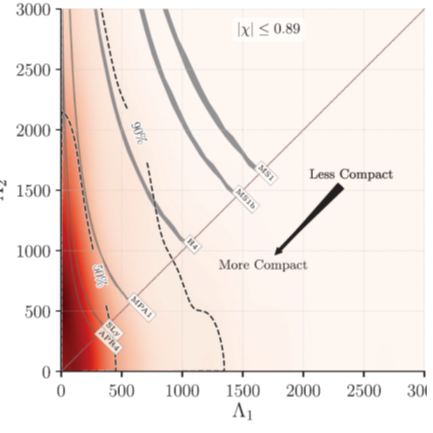The goal of this project …
The goal of this project is to provide quantitative predictions of the key parameters that govern the emission of measurable signals from compact objects, based on the uncertainties associated with subjective microphysics.

Credit: B.P.Abbott et al. PRL 119, 161101 (2017)
Three different phenomenologies will be studied
The emission of GW from neutron star binaries and associated parameters (tidal polarizability, r-modes). In this case the dominant uncertainties are due to the EoS modeling, and the possible phase transitions of the dense matter.
The dynamics of CCSN collapse and the estimation of the emitted neutrino spectrum, with a unified treatment of the EoS and the distribution of nuclei at thermodynamic equilibrium. The sources of uncertainty then lie in the nuclear mass model and in the EC rates.
The cooling of neutron stars and the crystallization of the crust. For these phenomena the uncertainties in the modeling derive both from the EoS (for isolated or non-isolated stars) and from the surface properties of very neutron-rich nuclei.
Method / Development plan
The main ingredients of nuclear physics that enter into the modeling are the energy function of homogeneous matter, EC levels, neutrino transport and the masses of very neutron-rich nuclei. Over the 36-month duration of the project we expect : (i) develop an empirical description of these four aspects, explicitly constrained on microscopic calculations of the DFT and chiral EFT type, and (ii) study their influence on the different astrophysical phenomena. During the previous MAC project we developed a meta-modeling of homogeneous and inhomogeneous matter, as well as a perturbing method for the evaluation of the nuclear distribution. We will now extinguish these theoretical tools to include different relativistic effects, the possibility of high density phase transitions, the explicit temperature dependence of the functional, and the phenomenon of crystallization at low temperature. The surface properties of neutron-rich nuclei will be studied with ETF and HFB data-constrained techniques. As far as nuclear data are concerned, sensitivity studies and mass measurements performed with MAC have allowed us to identify the key nuclei and observables involved in the collapse and we now propose to establish the most relevant experimental measurements to be proposed to better constrain them.
Expected results
Participating labs
Some working documents
TIDAL DEFORMATIONS OF NEUTRON STARS WITH ELASTIC CRUSTS
F. Gittins, N. Andersson and J. P. Pereira
GW190814: GRAVITATIONAL WAVES FROM THE COALESCENCE OF A 23 M BLACK HOLE WITH A 2.6 M COMPACT OBJECT
LIGO Scientific Collaboration and Virgo Collaboration
GW190814: GRAVITATIONAL WAVES FROM THE COALESCENCE OF A 23 SOLAR MASS BLACK HOLE WITH A 2.6 SOLAR MASS COMPACT OBJECT
The Astrophysical Journal Letters, 896:L44 (20pp), 2020 June 20
© 2020. The American Astronomical Society